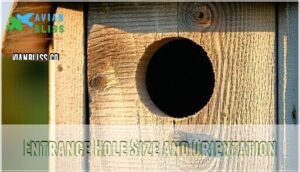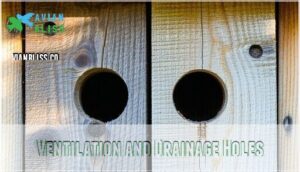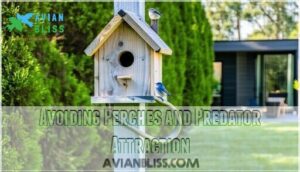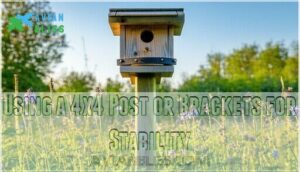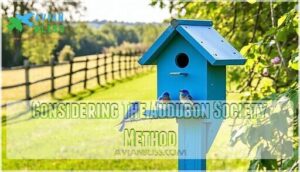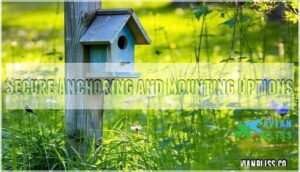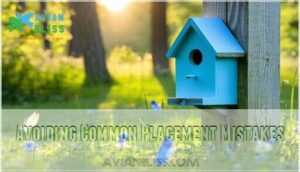This site is supported by our readers. We may earn a commission, at no cost to you, if you purchase through links.
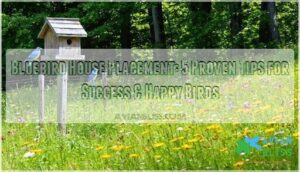 You’ll attract more bluebirds by placing houses in sunny, open areas with short grass—perfect hunting grounds for these insect-loving birds.
You’ll attract more bluebirds by placing houses in sunny, open areas with short grass—perfect hunting grounds for these insect-loving birds.
Mount your bluebird house 5-6 feet high on a pole, facing away from prevailing winds and harsh afternoon sun.
Position it at least 100 yards from dense woods or shrubs where house wrens lurk, ready to compete for prime real estate.
Choose spots with clear flight paths and scattered perches like fence posts nearby.
The magic happens when you nail the sweet spot between open grassland and light tree coverage, which is a key factor in becoming a successful bluebird landlord.
Getting these fundamentals right sets the stage for understanding the finer details that separate successful bluebird landlords from disappointed hopefuls.
Table Of Contents
- Key Takeaways
- Choosing Bluebird House Location
- Essential Bluebird House Features
- Bluebird House Placement Considerations
- Mounting Bluebird House Successfully
- Avoiding Common Placement Mistakes
- Frequently Asked Questions (FAQs)
- Which way should you face a bluebird house?
- How do you attract bluebirds to a new bluebird house?
- Where’s the best place to put a bluebird house?
- Why should bluebird houses face east?
- What direction should a bluebird house face?
- Where is the best place to put a bluebird house?
- Can I put a bluebird house on a tree?
- How to attract bluebirds to a bluebird house?
- What direction should a bluebird house face for optimal sunlight?
- How far apart should multiple bluebird houses be installed?
- Conclusion
Key Takeaways
- Choose sunny, open areas with short grass – You’ll attract more bluebirds by placing houses where they can easily hunt insects, avoiding dense woods or shrubs that harbor competitors like house wrens.
- Mount at proper height and spacing – You should install your house 5-6 feet high on a pole, spacing multiple houses 100-300 feet apart to prevent territorial conflicts between nesting pairs.
- Face east for weather protection – You’ll minimize rain entry and harsh wind exposure by positioning the entrance hole toward the east, providing gentle morning warmth while avoiding afternoon storms.
- Install predator guards and avoid perches – You’ll keep nesting families safe by adding baffles below the house and choosing designs without perches, which only help competitors and predators access the nest.
Choosing Bluebird House Location
You’ll want to pick the perfect spot for your bluebird house because location makes all the difference between attracting these beautiful birds and watching them fly right past your yard.
The right placement combines sunny open areas, proper spacing, and smart positioning that mimics their natural preferences while keeping them safe from predators.
Sunny Open Areas With Short Grass
You’ll want to place your bluebird house in sunny, open areas where these feathered friends can easily spot their next meal. Think of it as prime real estate for birds – location makes all the difference for nesting success and attracting bluebirds to your yard.
- Keep grass height under 6 inches for ideal insect hunting visibility
- Ensure 6+ hours of direct sunlight exposure daily for warmth and comfort
- Choose open spaces with minimal tree cover to maximize predator visibility and openness benefits
Avoiding Deep Shade and Bushy Areas
Dense brush and thick vegetation create perfect hiding spots for bluebird predators like snakes, cats, and raccoons.
You’ll want to avoid placing your birdhouse near overgrown areas where predators can easily conceal themselves. Bluebirds prefer open flightways with clear sunlight exposure, making vegetation density a key factor in nesting success.
Choose locations with scattered trees rather than dense woodland for ideal bluebird habitat and attracting bluebirds safely. Proper placement considers species-specific guidelines for attracting bluebirds, which is crucial for nesting success and ensuring the birds’ safety from predators.
Proximity to Water Sources and Vegetation
Water source proximity matters more than you might think for successful bluebird house placement.
These birds need fresh water within 100 yards for drinking, bathing, and finding moisture-loving insects that make up their diet.
- Sparkling morning dew on nearby grass provides essential hydration for hungry nestlings
- Berry-laden shrubs offer winter sustenance when insects become scarce
- Native vegetation creates perfect hunting grounds teeming with crickets and beetles
- Balanced shade from scattered trees keeps baby birds cool without blocking flight paths
Considering The Three Bluebird Species’ Needs
Different bluebird species have unique habitat preferences that affect your bluebird house placement.
Eastern Bluebirds love open meadows and pastures with scattered trees. Western Bluebirds prefer woodland edges and burned forests.
Mountain Bluebirds thrive in high-elevation grasslands up to 12,500 feet. Understanding these regional variations helps you choose the perfect bluebird house location for your local species and boosts nesting success.
These birds are part of the thrush family.
Essential Bluebird House Features
You’ll want to build your bluebird house with specific features that make these picky birds feel right at home.
The right entrance hole size, proper ventilation, and easy access for cleaning can mean the difference between a thriving bluebird family and an empty house collecting dust, which is why proper ventilation is crucial.
Entrance Hole Size and Orientation
Getting the hole diameter just right makes all the difference for your feathered friends.
You’ll want a 1.5-inch entrance hole positioned 5-6 inches from the floor for Eastern Bluebirds.
Face your birdhouse east or northeast – this orientation direction protects against harsh weather while welcoming morning sun.
Remember, proper hole height and species preference matter more than fancy predator baffles when selecting your bluebird nesting box location.
Ventilation and Drainage Holes
Your bluebird house needs proper airflow and drainage to keep those feathered tenants comfortable and healthy.
Think of it like installing tiny windows and gutters for your backyard birds!
Here’s what your bluebird nesting box requires:
- Ventilation holes – Drill small holes near the roof corners to prevent overheating during summer months
- Drainage holes – Add quarter-inch holes in the floor corners so rainwater won’t pool inside
- Gap spacing – Leave a small gap between the roof and walls for additional airflow
These simple birdhouse placement tips guarantee nesting bluebirds stay cool and dry throughout their breeding season.
Easy Opening for Monitoring and Cleaning
Your bluebird house needs quick access for regular check-ups! Choose models with front-opening panels or removable tops featuring secure latch mechanisms.
Side-hinge types work great too. Easy access lets you monitor nesting progress and clean between broods.
Regular cleaning frequency prevents parasites and disease. Consider an easy to maintain birdhouse for simpler upkeep.
These monitoring benefits keep your feathered friends healthy and coming back season after season, ensuring a successful and healthy environment!
Avoiding Perches and Predator Attraction
While it looks helpful, perches actually invite trouble to your backyard bluebirds’ doorstep.
Smart bluebird house designs ditch these landing spots entirely.
Here’s why perch prevention works:
- House Sparrows can’t easily access nest boxes without perches
- Snake deterrents work better when combined with smooth pole surfaces
- Bird predators struggle to grip smooth nest box material
Your feathered friends don’t need perches anyway—they’re excellent at clinging to entrance holes.
Install predator guards instead for real protection around nesting sites.
Bluebird House Placement Considerations
You’ll need to take into account several key factors when selecting the perfect spot for your bluebird house.
The right placement can make the difference between attracting these beautiful birds or watching them fly right past your carefully chosen home.
1. Bluebird House Wooden Birdhouse
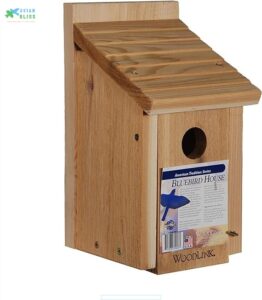
Quality wooden birdhouses offer superior weather resistance and construction durability compared to plastic alternatives.
You’ll want cedar or pine materials that naturally repel moisture and insects.
Look for thick walls, reinforced joints, and quality hardware that won’t rust.
A well-built wooden birdhouse creates an inviting aesthetic design that attracts backyard bluebirds while withstanding years of outdoor conditions.
Consider optimal sun exposure for attracting birds.
2. Bluebird House Wood Peterson Stovall

Peterson Stovall designs combine durability factors with aesthetic appeal that’ll make your neighbors jealous.
These wood type houses feature solid construction using cedar or pine, ensuring years of reliable service.
The Stovall design incorporates Peterson features like proper ventilation and easy monitoring access.
When mounting bluebird house units, you’ll appreciate the thoughtful engineering that considers both bluebird house height and bluebird house direction requirements.
These models excel in bluebird house spacing scenarios where multiple units create successful nesting communities.
3. Bluebird House Predator Guard
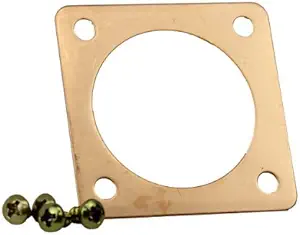
Protecting your bluebird house from sneaky predators keeps families safe and thriving.
Smart Guard Types like baffles and hardware cloth create fortress-like barriers. Guard Maintenance means checking monthly for damage or gaps predators exploit.
Here’s what effective predator deterrence looks like:
- Snake guards wrapped around poles like slippery metal sleeves
- Raccoon baffles positioned below the birdhouse entrance like umbrellas
- Hardware cloth covering ventilation holes to block tiny invaders
- Mounting Guards secured tightly without gaps or loose edges
Deterring Predators requires identifying threats first – watch for claw marks, disturbed nesting materials, or missing eggs.
4. Bluebird House Pole Set 54 Inch

A 54-inch pole set provides the perfect mounting height for bluebird success.
This Pole Set Height places your house at the recommended 4-6 feet, making monitoring easy while keeping predators guessing.
Quality Pole Material Options like galvanized steel resist weather and wobbling.
Ground Mounting Depth of 12-18 inches guarantees stability during storms.
| Feature | Specification | Benefit |
|---|---|---|
| Pole Set Assembly | Pre-drilled holes, hardware included | Quick 30-minute setup |
| Predator Baffle Use | Compatible with standard baffles | Protects nesting sites from climbers |
| Height Adjustment | Telescoping sections available | Matches bluebird house plans perfectly |
| Material Durability | Powder-coated steel construction | Supports bluebird conservation for years |
Mounting Bluebird House Successfully
Proper mounting creates the foundation for successful bluebird nesting and keeps your feathered friends safe from predators and weather.
You’ll need the right combination of height, stability, and secure anchoring to turn your bluebird house into a thriving home that attracts these beautiful birds year after year, with successful bluebird nesting being the ultimate goal.
Installing a Bluebird House With a Steel Rebar Pole
Steel rebar makes an excellent bluebird house mounting option.
Drive a 5/8-inch diameter rebar 18-24 inches into the ground, leaving 4-6 feet above ground for proper bluebird house height.
Choose galvanized rebar to prevent pole rust and guarantee pole installation safety.
You can source galvanized steel products online for this purpose.
The rebar pole depth depends on ground conditions – rocky soil needs pre-drilling while soft earth allows direct hammering.
This simple method supports nest boxes perfectly while meeting bluebird conservation requirements.
Using a 4×4 Post or Brackets for Stability
A sturdy 4×4 post creates rock-solid post stability for your bluebird house height needs.
You’ll want pressure-treated lumber that laughs in the face of weather. Secure bracket options include metal mounting plates or wooden brackets.
Consider predator baffles below nest boxes to keep sneaky critters away. For added security, explore sturdy mounting flanges to prevent wobbling.
This method works perfectly for bluebird trail installations where multiple nesting sites need consistent, reliable support.
Considering The Audubon Society Method
When you follow Audubon’s recommendations, you’re tapping into decades of bird conservation research.
Their method uses steel rebar and galvanized conduit for mounting, creating smooth surfaces that deter climbing predators.
This approach dramatically improves nesting success rates while supporting local guidelines for habitat preferences.
It’s like giving bluebirds their own fortress—perfectly engineered for their specific needs and birdwatching enthusiasts’ conservation impact.
Ideal placement considers the need for open country backyards.
Secure Anchoring and Mounting Options
You’ll want rock-solid anchoring to keep your nest boxes standing strong through storms and seasons.
Choose materials that’ll last years without wobbling or tipping over.
- Pole Mounting: Use galvanized steel poles with ground anchors driven 18-24 inches deep for maximum stability
- Baffle Systems: Install predator guards and baffles directly onto post materials before mounting your bird box
- Post Materials: Select treated wood 4x4s or metal conduit that won’t rot or bend under weather pressure.
Consider a suitable mounting pole for ideal placement.
Avoiding Common Placement Mistakes
Even experienced birders can make placement mistakes that leave their bluebird houses empty season after season.
You’ll want to avoid these common errors to create the perfect home that actually attracts nesting pairs.
Avoiding Proximity to Dense Cover and House Wrens
Why place your bluebird house near thick bushes when House Sparrows and wrens love dense cover?
Keep nest boxes in Open Areas, at least 50 feet from Habitat Edges.
Dense Cover Proximity invites aggressive cavity nesters who’ll harass bluebirds.
Smart Wren Management means choosing spots where these feisty competitors can’t easily ambush.
Your bluebirds need clear flight paths, not bird habitat jungle gyms that hide predators.
To further deter wrens, consider that entrance hole size impacts occupancy.
Discouraging House Wren Attacks With Additional Nest Boxes
Clever bluebird enthusiasts use a simple trick: install additional nest boxes to distract territorial house wrens.
Space these decoy boxes 100 feet apart from your main bluebird houses.
Wrens will focus on their preferred shrubby habitat boxes, leaving your bluebirds alone.
This strategic nest box spacing reduces aggressive bird behavior and creates peaceful wren territory boundaries.
Considering Heat Shields or Screens in Warmer Climates
Hot climates can spell trouble for your feathered friends!
Shield materials like aluminum or cedar shingles protect against overheating prevention while screen effectiveness helps maintain airflow.
Regional differences matter—southern states need more protection than northern areas.
These simple additions boost bluebird comfort and support proper bluebird care during scorching summers when bird watching reveals stressed bluebird behavior.
Choosing a Protected Location With Open Flight Paths
Perfect bluebird habitat balances safety with accessibility.
You need predator avoidance while ensuring clear flight paths for hunting success. Smart placement creates a bird watching paradise.
Consider these essential flight accessibility factors:
- Open approach zones – Clear 50+ feet of flight space for insect hunting and nesting safety
- Wind exposure protection – Shield from harsh prevailing winds while maintaining airflow for cavity ventilation
- Sun direction positioning – East-facing openings reduce weather exposure and optimize bird habitat conditions
Frequently Asked Questions (FAQs)
Which way should you face a bluebird house?
You’ll want to face your bluebird house opening toward the east.
This direction helps minimize rain exposure and protects against strong prevailing winds.
North-facing is your second-best option for similar protection benefits.
How do you attract bluebirds to a new bluebird house?
Picture your freshly mounted bluebird house standing empty in the morning sun.
You’ll attract these beautiful birds by placing it in sunny, open areas with short grass where they can easily spot insects below and feel safe approaching their new home.
They can easily spot insects below and feel safe approaching their new home.
Where’s the best place to put a bluebird house?
Place your bluebird house in sunny, open areas with short grass, mounted 4-6 feet high. Face the opening east or north, spacing houses 100-300 feet apart to prevent territorial conflicts.
Why should bluebird houses face east?
Bluebird houses face east to minimize rain entry and reduce exposure to prevailing winds.
This orientation protects eggs and nestlings from harsh weather while providing gentle morning warmth to start their day right, with gentle morning warmth being crucial for their development.
What direction should a bluebird house face?
You’ll want to position your bluebird house facing east to minimize rain entry and reduce exposure to harsh prevailing winds, creating ideal nesting conditions for successful breeding.
Where is the best place to put a bluebird house?
Like a lighthouse guiding ships to safe harbor, your sunny, open area with short grass becomes a beacon for nesting bluebirds.
Mount your house 4-6 feet high, 100-300 feet from other boxes, facing east in meadows or field edges.
Can I put a bluebird house on a tree?
You shouldn’t mount bluebird houses directly on tree trunks.
Trees make it easier for predators like cats, raccoons, and snakes to climb up and raid nests, putting your feathered friends at risk.
How to attract bluebirds to a bluebird house?
Just as birds naturally gravitate toward perfect nesting spots, you’ll attract bluebirds by placing your house in sunny, open areas with short grass.
Mount it 4-6 feet high, facing east, near scattered perches for hunting insects.
What direction should a bluebird house face for optimal sunlight?
Position your bluebird house facing east for ideal sunlight and weather protection.
Eastern exposure provides gentle morning warmth while avoiding harsh afternoon sun and prevailing westerly winds that could drive rain inside, which is why eastern exposure and gentle morning warmth are crucial.
How far apart should multiple bluebird houses be installed?
Give your bluebirds breathing room!
You’ll need 100-300 feet between houses to prevent territorial squabbles.
This spacing lets each pair claim their turf without turning your backyard into a feathered battleground.
Conclusion
Perfect bluebird house placement transforms your backyard into a thriving bluebird paradise!
You’ve discovered the secrets that’ll make neighboring birders incredibly jealous.
Remember, sunny open areas with short grass create ideal hunting grounds, while proper mounting height and distance from competitors guarantees success.
Your careful attention to entrance hole size, ventilation, and predator guards completes the winning formula.
Master these bluebird house placement fundamentals, and you’ll soon enjoy watching these beautiful birds raise their families right outside your window.
- https://www.youtube.com/watch?v=3RLwBgBfQm0
- https://hgic.clemson.edu/factsheet/providing-for-bluebirds-guidance-for-bluebird-nest-box-establishment-in-south-carolina/
- https://www.sciencing.com/direction-should-bluebird-house-face-5627646/
- https://duncraft.com/blogs/birding-tips/where-s-the-best-place-to-put-a-bluebird-house
- https://www.nabluebirdsociety.org/PDF/NABSFactsheetGettingStarted.pdf

